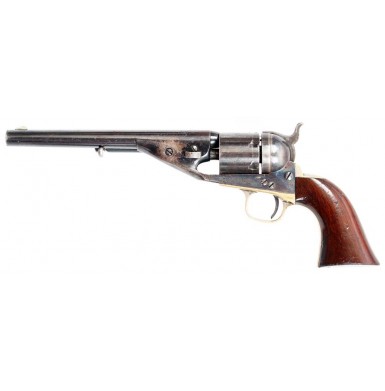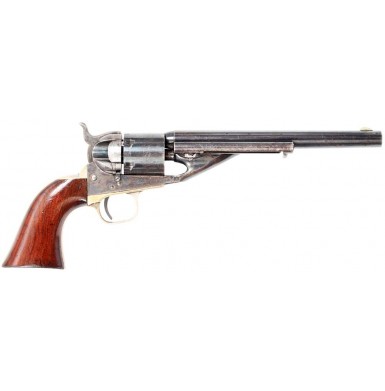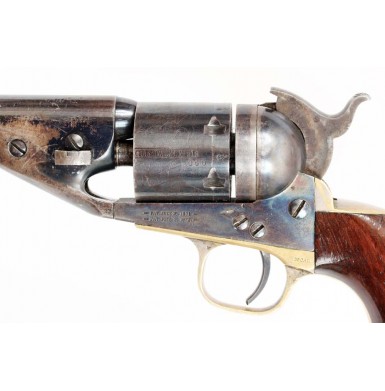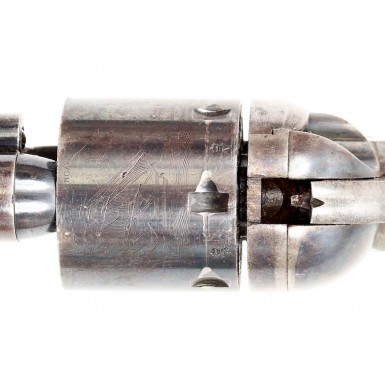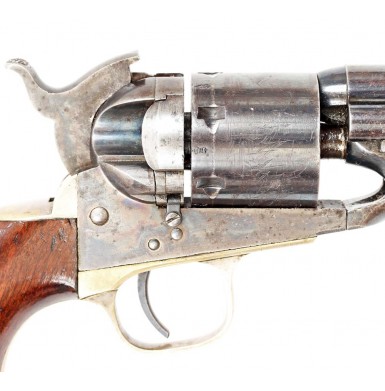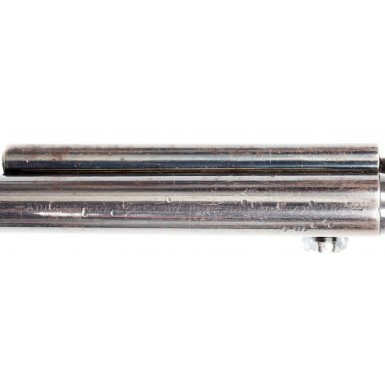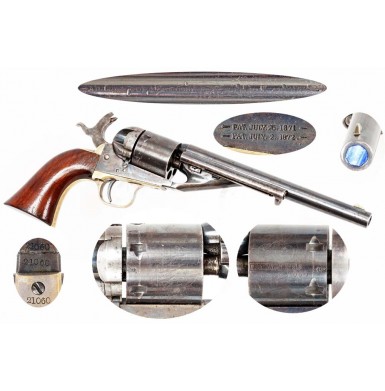Colt M-1861 Navy Richards-Mason Conversion - Excellent
- Product Code: FHG-1684-SOLD
- Availability: Out Of Stock
-
$1.00
With the end of the American Civil War many American firearms companies found themselves in a quandary regarding their future. The immediate demands for arms from a huge internal conflict had come to an end, and with it had come the apparent end to the percussion era. The large numbers of various patent firearms utilizing self contained metallic cartridges had proved their worth during the war, and for most companies it was obvious that their future lay in the production of metallic cartridge arms and not percussion ones. Nowhere was that more apparent than at Colt Patent Firearms, where an end to the war and the huge demand for handguns had reduced the output from the “Under The Blue Dome” to a mere trickle. During 1862, 1863 and 1864, Colt had produced between 60,000 and 65,000 Model 1860 Army Revolvers per year, however between 1865 and 1870 Colt only produced a total of 32,000 M-1860 revolvers; about half the output of a single war year, over the course of five years! It was not just the cessation of hostilities that had brought America’s premier handgun manufacturer to its knees, but the reduced demand for percussion revolvers. Cartridge firearms like Lefaucheux’s revolutionary pinfire revolvers had worked well during the war and had shown the distinct advantages of loading and unloading much quicker. They also utilized ammunition that was not likely to become damaged when it was handled or useless if it became wet. Other Union cartridge revolvers like the Raphael and the Perrin were less successful mechanically, but showed the same advantages in ammunition. The US military had clearly shown its preference for cartridge arms with the adoption of the 1st Allin conversion of Civil War produced muzzle loading rifle muskets in 1865, and kept refining their design with subsequent Allin improvements. The US military was also looking for an inexpensive way to upgrade its large inventory of percussion revolvers (primarily Colts & Remingtons) to cartridge as well. Colt, however, was stymied by the fact that Smith & Wesson owned the rights to the Rollin White patent on the bored through cylinder. This effectively prevented Colt from producing a metallic cartridge revolver that loaded and operated the way we expect a revolver to function today. They were forced to come up with an alteration process that could convert existing percussion revolvers to metallic cartridge, without violating White’s patent. They found their solution in the design of Alexander Thuer, who came up with the first of the Colt cartridge alterations. Thuer’s design required the rear of the percussion cylinder to be machined turned down, leaving a central portion of the cylinder its original full length. A conversion ring was then placed over this turned down portion, with floating firing pin. The conversion ring was not bored through, and the cylinder was loaded from the front, which effectively circumvented the Rolling White patent. This also allowed the conversion cylinder and ring to be removed and a convention percussion cylinder re-installed should the user run out Thuer cartridges. The system worked, but was hardly simple or popular, and in the end only about 5,000 Colts of all patterns were altered (or produced from previously unused parts on hand) by the Thuer method. However, Colt now had some experience with the concept of metallic cartridge alteration and production, and with the expiration of White’s patent protection in 1869, the company moved forward with Richards Conversion system. Richards altered Colt Armies were produced from 1871 to 1878, with about 9,000 guns being altered or produced from a mixture of newly made and previously unused parts on hand. The Richards system introduced the loading gate on the right hand side of the cylinder, and a spring retained ejector rod on the right side of the barrel. The guns also used an improved conversion plate or ring at the rear of the cylinder, but still used a firing pin in the conversion ring for ignition. The loading lever was removed and the hole the frame through which the plunger passed was filled. The guns were typically refinished at the factory after the alteration process, so the altered revolvers came out looking brand new. The downsides to the Richards system were the complicated machining of the conversion ring with the captive firing pin, and the overly complex and in some ways delicate ejector rod. These shortcomings were eliminated with the Richards-Mason conversions. This conversion system utilized an improved ejector design that had been patented by William Mason. Using lessons learned from their production of the M-1871 “Open Top”, Colt’s the first “from the ground up” made as a cartridge revolver design, and the subsequent M-1873 Single Action Army, the Richards-Mason conversions were the pinnacle of Colt’s cartridge alterations. Like the other conversion revolvers, the Richards-Mason used a conversion ring at the rear of the cylinder, but it no longer had a floating firing pin, as the pin was now attached to the hammer face. This allowed the system to be used for either center fire or rimfire chamberings. Although the reloadable centerfire system was going to win out in the long run, the desire to carry a handgun chambered in .44 Rimfire like your Henry or Winchester 1866 rifle made this chambering an attractive option in a revolver. The Richards-Mason conversion also used a simplified and more robust ejector rod system that was a major improvement over the Richards conversions. Even though the M-1873 Single Action Army was in production, the mid to late 1870s saw many Colt percussion revolvers altered to cartridge by both the Richards and Richards-Mason systems. This made good sense for those that already owned a percussion revolver and could not afford the expense of a new cartridge Colt. Even for those who did not own a percussion Colt, their availability on the used gun market after the Civil War still made purchasing a percussion Colt and sending it back to the factory for conversion a cheap way to get a quality cartridge handgun.
Offered here is a truly EXCELLENT example of a Richards Mason Converted Colt M-1861 Navy Revolver. The M-1861 Navy is considered by many collectors and Colt aficionados as the pinnacle of Colt percussion handgun development. The easy handing of the Colt M-1851 Navy sized frame, grip and caliber, combined with the sleek lines of the M-1860 Army revolver, resulted in a very attractive handgun. Only 38,843 Colt M-1861 (New Model) Navy revolvers were produced during its production lifespan form 1861 through 1873, making it one of the lesser produced guns in the Colt line. During the mid-to-late 1870s, some Colt altered about 2,200 of these guns to cartridge via the Richards-Mason system. The guns were offered either in .38 Rimfire or .38 Centerfire (.38 Colt), and are classified into three types. The first type was produced from unfinished and unused M-1861 Navy parts on hand at the Colt factory. The second type were US Navy owned M-1861 revolvers that were sent back to the factory for alteration to cartridge. The third type were percussion guns sent back to the factory by their civilian owners for upgrade and conversion to cartridge. This revolver is one of those third type guns. It is serial numbered 21060, and was originally manufactured and sold in 1864. At some point during the second half of the 1870s its owner returned the revolver to the factory and had it upgraded to .38 Colt centerfire. The pistol remains in excellent condition after its trip to Hartford some 135+ years ago. It retains about 80%+ of the factory blue that was applied at that time to the barrel and cylinder, and 85%+ vivid case coloring on the frame. The frame shows some lightly scattered oxidized surface freckling, most of which is on the right side of the frame, and a some light freckling is scattered on the barrel web and barrel as well. This is quite minimal and does not really signify in normal lighting. The hammer retains about 70% vivid case coloring, but shows more fading and muting to the color than the frame does, which remains amazingly vibrant. The barrel shows a handful of impact marks around the wedge and along the top, and two of the impact marks have revealed gray metal under the factory-blued finish. This should be visible in the photos below. The factory refinishing of the guns was necessary, as the loading lever was removed and the plunger hole in the front of the frame was plugged. Additionally other machining and fitting of parts (most notably the conversion ring with loading gate, the ejector system and the firing pin) would have necessitated refinishing to make the gun look good again. Many of the Richards-Mason altered revolvers were refinished in nickel, so a high condition blued gun is a rare and highly coveted revolver. The revolver has matching numbers throughout, with 21060 on the barrel, frame, trigger guard and grip frame. The wedge is an un-numbered Colt wedge without a spring, typical of mid-to-late 1870s Colt percussion conversion revolvers. These newly made, “springless’ wedges were often installed in Richards-Mason conversion revolvers and are 100% correct for the gun. The cylinder arbor pin in marked with the abbreviated 1060, and this number is also present on the rear of the conversion ring loading gate. The cylinder bears two serial number: 213 and a matching 060, along with a set of London proof marks between the chambers. This strange set of markings is explained by R. Bruce McDowell in his exhaustive work A Study of Colt Conversion and Other Percussion Revolvers. Apparently a handful of guns with these British proved Richards-Mason altered M-1861 cylinders with two sets of numbers are known. It is believed that the cylinders were originally proved in England when they were part of percussion revolvers whose serial numbers ended with the 3 numbers on the line with the Colt’s Patent mark. Those guns were subsequently altered to the Thuer system with newly made Thuer cylinders, and the eventually all unused and reusable Colt parts in London were returned to the Hartford factory, where the cylinders were machined for use in Richards-Mason alterations and then numbered to the guns they were installed in. The revolver bears the post-July 1872 set of patent marks on the lower left of the frame: - PAT. JULY 25, 1871 - over - PAT. JULY 2 1872 -, which were stamped on the Richards-Mason conversion performed after those dates. The revolver bears the standard single-line M-1861 Navy percussion era barrel address: - ADDRESS COL. SAML COLT NEW-YORK U.S. AMERICA -. The revolver is mechanically excellent and functions perfectly in all respects. The action is crisp and tight, and the cylinder times, indexes and locks up exactly as it should. The loading gate operates correctly as well and snaps closed securely. The gate is the later era Richards-Mason design, with the improved, external gate spring. The ejector rod functions smoothly and the spring retains strong tension, easily pulling the rod back into its housing after using it. The original and correct concentric ringed “target” style ejector rod head is in place at the end of the rod, as it should be. The cylinder retains about 90%+ of the original WL Ormsby roll engraved Texas Navy battle scene, with the notable exception of the rear section of the cylinder that was machined off during alteration. The front edge of the cylinder still retains a very legible: ENGAGED MAY 16, 1843 legend. The bore of the revolver is in about EXCELLENT condition and is very bright, retaining crisp rifling and only some lightly scattered pinpricking and minor pitting in the grooves. Even the screws remain in very fine condition, with most of them retaining large amounts of their fire tempered blue and the slot wear, where visible, is quite minimal. The brass frame retains only traces of the original silver plating from the revolver’s percussion days, and may have been polished to bright brass during the conversion process. Colt did not typically re-plate the brass frames of altered guns and usually polished them bright. The brass has a wonderfully mellow, golden butterscotch color that is quite attractive. The one-piece wood grip is in similarly EXCELLENT condition and retains about 80%+ of its original Colt varnish. The majority of the finish loss is along the sharp edges around the bottom of the grip. The grip is free of any breaks, cracks or repairs, but does show the expected bumps, dings and minor marks from handling and use that revolver of this age would have experienced during its life. The grip fit is excellent and is clearly original to the revolver.
Overall this is simply a stunning example of the rarely encountered Richards-Mason M1861 Navy Conversion Revolver. Colt M-1861Navy revolvers are scarce in their own right, with less than 40,000 being produced, versus over 215,000 Colt M-1851 Navies and over 200,000 Colt M-1860 Armies! Only 2,200 M-1861 Navies were altered by the Richards-Mason system, making it one of the harder large frame Colt factory conversions to find for sale. It is particularly hard to find these guns in this state of preservation, and even harder to find one with so much factory finish in blue! This is one of those scarce colt alterations that deserves a place in a truly advanced Colt collection, and the gun is so attractive there is no doubt that it will please even the most critical of collectors. According to the newest Blue Book of Gun Values, a Richards-Mason altered M-1861 Navy in 70% condition is valued at $10,000. If the recent sale prices brought by high condition Colt conversions at the James D Julia auction this past March is any indication, the Blue Book might be under valuing these guns! This gun is certainly a strong 80%-85% gun at the least, and it is priced well under what a 70% revolver is currently valued at. The photos below simply don’t do the condition and quality of this revolver justice. I am quite positive that you will be extremely happy with this excellent and rare example of a Richards-Mason Colt M-1861 Navy Revolver in .38 Colt when you hold it in your hands.
SOLDTags: Colt, M, 1861, Navy, Richards, Mason, Conversion, Excellent


